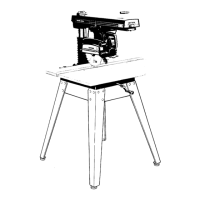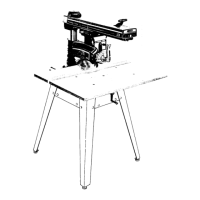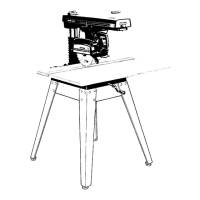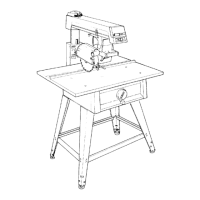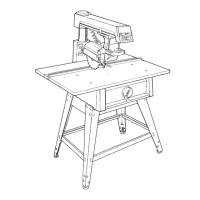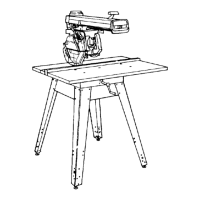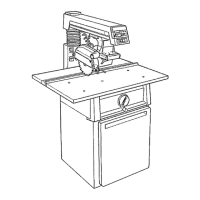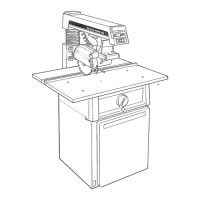14. Rip workpieces that are longer than the
diameter of the blade being used. Do not rip
a workpiece that is shorter than the diameter
of the blade being used.
15. Cut only one workpiece at a time. Do
not cut stacked workpieces or lay them edge
to edge for cutting.
Workpiece Support Safety
1. Use additional supports for workpieces
which extend beyond the saw table. Large
workpieces can shift, twist, rise from table or
fall after they are cut.
2. Helpers can be hit by a thrown workpiece,
workpiece chips or pieces of the blade. Use
table extensions or other supports. Do not
use helpers.
3. ttelpers can cause the workpiece to kick-
back. Do not use other people to support or
assist in feeding or pulling the workpiece.
Use table extensions.
4. When table extensions over 24 inches wide
are added to either side of the saw, make
sure you either bolt the saw to the floor or
support the outer end of the extension from
the floor with sturdy legs or an outrigger.
5. Use Only Recommended Accessories
Follow the instructions that come with the
accessories.
Consult the owner's manual for recommended
accessories.
The use of improper accessories may cause
risk of injury to persons.
Blade Safety
1. Use blades marked for 3450 rpm or higher.
2. Do not use blades larger than 10 inches in
diameter.
3. Keep blade sharp and clean.
4. Do not cycle motor switch on and off rapid-
ly; the blade can loosen.
5. Do not overtighten the blade; the blade
collar can be warped.
Safety Labels on the Radial Arm Saw
The following labels are on your radial arm
saw. Locate, read and follow the safety in-
structions and information contained in these
labels.
1. Wrong way feed label located on the out-
feed end of the blade guard.
[ DANGER
TO AVOID
INJURY DO NOT
FEED MATERIAL
INTO CUTTING
TOOL FROM
THIS END
Fig. 7 Wrong Way Feed Label
2. Safety instruction label located on the
front of the saw near the handwheel.
[ DANGER ]
FOR YOUR OWN SAFETY:
1. Read and understand owner's manual
before operating machine.
2. Wear safety goggles complying with
ANSI Z87.1.
3. Keep hands out of path of saw blade.
4, Never reach around the saw blade.
5. Never perform any operation
"FREEHAND:'
6. Return carriage to the full rear position
after each cross-cut type operation,
7. Shut off power and allow saw blade to
stop before adjusting or servicing
Fig, 8 Safety Instruction Label
3. Ripping safety label located on the motor.
[ DANGER [ WHEN RIPPING
1. R4t_ I_,d un_wl_l_l OWTNW'$ mlmuM S. Ule "PUSH STICK" fo_ rmrrow work
_g remcl_k, te. 7_ Nev_ orm tony ope_t}o,n
2. _1 _gl_ €omplying wh11 6. Nev_ flinch mrour_ t h_ saw blade."FREt H_A_rl. "
3, Klmp hired= otlt of l_lth of sew b_. 8, Shut off power m_l allow IklW I_qKIll tO
4. Know hOW Io #_k:l _KICKBACKS? MOp before Kljusti_ Or _.rvi¢ing.
TO AVOID RUNAWAY WORKP!IECE
ALWAYS _ WORXPIECE k_,to
cutting tool FT!OM TH_ B40 ONLY
DANGER AT OUTFEED
Workpi4bco c4_ smc_d4_W k_k _BCk
__ @pul h,t_do int o arKI und_ r.utU_l tool
MOtOr: 120Volts 11.0Ampl 3450 R.P.M. 60Hz. t Phase ModelC48HM'275
Fig. 9 Ripping Safety Label
